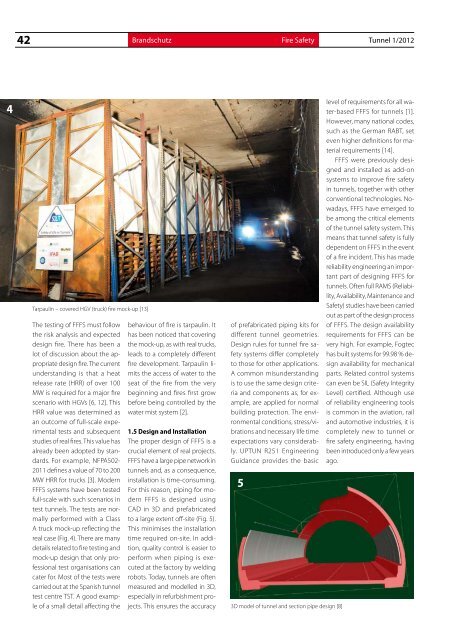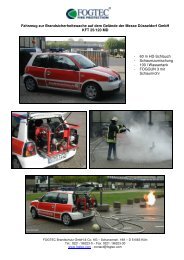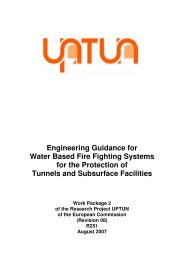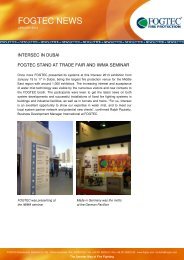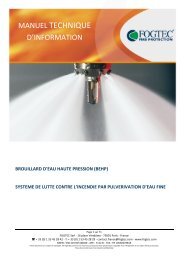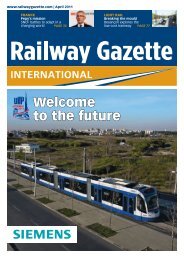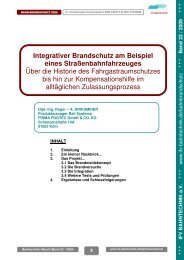Fixed Fire Fighting Systems for Road and Rail Tunnels - FOGTEC
Fixed Fire Fighting Systems for Road and Rail Tunnels - FOGTEC
Fixed Fire Fighting Systems for Road and Rail Tunnels - FOGTEC
You also want an ePaper? Increase the reach of your titles
YUMPU automatically turns print PDFs into web optimized ePapers that Google loves.
42 Br<strong>and</strong>schutz<br />
<strong>Fire</strong> Safety Tunnel 1/2012<br />
4<br />
level of requirements <strong>for</strong> all water-based<br />
FFFS <strong>for</strong> tunnels [1].<br />
However, many national codes,<br />
such as the German RABT, set<br />
even higher definitions <strong>for</strong> material<br />
requirements [14].<br />
FFFS were previously designed<br />
<strong>and</strong> installed as add-on<br />
systems to improve fire safety<br />
in tunnels, together with other<br />
conventional technologies. Nowadays,<br />
FFFS have emerged to<br />
be among the critical elements<br />
of the tunnel safety system. This<br />
means that tunnel safety is fully<br />
dependent on FFFS in the event<br />
of a fire incident. This has made<br />
reliability engineering an important<br />
part of designing FFFS <strong>for</strong><br />
tunnels. Often full RAMS (Reliability,<br />
Availability, Maintenance <strong>and</strong><br />
Tarpaulin – covered HGV (truck) fire mock-up [13]<br />
Safety) studies have been carried<br />
out as part of the design process<br />
The testing of FFFS must follow<br />
the risk analysis <strong>and</strong> expected<br />
design fire. There has been a<br />
lot of discussion about the appropriate<br />
design fire. The current<br />
underst<strong>and</strong>ing is that a heat<br />
release rate (HRR) of over 100<br />
MW is required <strong>for</strong> a major fire<br />
scenario with HGVs [6, 12]. This<br />
HRR value was determined as<br />
an outcome of full-scale experimental<br />
tests <strong>and</strong> subsequent<br />
studies of real fires. This value has<br />
already been adopted by st<strong>and</strong>ards.<br />
For example, NFPA502-<br />
behaviour of fire is tarpaulin. It<br />
has been noticed that covering<br />
the mock-up, as with real trucks,<br />
leads to a completely different<br />
fire development. Tarpaulin limits<br />
the access of water to the<br />
seat of the fire from the very<br />
beginning <strong>and</strong> fires first grow<br />
be<strong>for</strong>e being controlled by the<br />
water mist system [2].<br />
1.5 Design <strong>and</strong> Installation<br />
The proper design of FFFS is a<br />
crucial element of real projects.<br />
FFFS have a large pipe network in<br />
of prefabricated piping kits <strong>for</strong><br />
different tunnel geometries.<br />
Design rules <strong>for</strong> tunnel fire safety<br />
systems differ completely<br />
to those <strong>for</strong> other applications.<br />
A common misunderst<strong>and</strong>ing<br />
is to use the same design criteria<br />
<strong>and</strong> components as, <strong>for</strong> example,<br />
are applied <strong>for</strong> normal<br />
building protection. The environmental<br />
conditions, stress/vibrations<br />
<strong>and</strong> necessary life time<br />
expectations vary considerably.<br />
UPTUN R251 Engineering<br />
Guidance provides the basic<br />
of FFFS. The design availability<br />
requirements <strong>for</strong> FFFS can be<br />
very high. For example, Fogtec<br />
has built systems <strong>for</strong> 99.98 % design<br />
availability <strong>for</strong> mechanical<br />
parts. Related control systems<br />
can even be SIL (Safety Integrity<br />
Level) certified. Although use<br />
of reliability engineering tools<br />
is common in the aviation, rail<br />
<strong>and</strong> automotive industries, it is<br />
completely new to tunnel or<br />
fire safety engineering, having<br />
been introduced only a few years<br />
ago.<br />
2011 defines a value of 70 to 200 tunnels <strong>and</strong>, as a consequence,<br />
MW HRR <strong>for</strong> trucks [3]. Modern installation is time-consuming.<br />
FFFS systems have been tested For this reason, piping <strong>for</strong> modern<br />
5<br />
full-scale with such scenarios in<br />
test tunnels. The tests are normally<br />
per<strong>for</strong>med with a Class<br />
A truck mock-up reflecting the<br />
real case (Fig. 4). There are many<br />
details related to fire testing <strong>and</strong><br />
mock-up design that only professional<br />
test organisations can<br />
cater <strong>for</strong>. Most of the tests were<br />
carried out at the Spanish tunnel<br />
test centre TST. A good example<br />
of a small detail affecting the<br />
FFFS is designed using<br />
CAD in 3D <strong>and</strong> prefabricated<br />
to a large extent off-site (Fig. 5).<br />
This minimises the installation<br />
time required on-site. In addition,<br />
quality control is easier to<br />
per<strong>for</strong>m when piping is executed<br />
at the factory by welding<br />
robots. Today, tunnels are often<br />
measured <strong>and</strong> modelled in 3D,<br />
especially in refurbishment projects.<br />
This ensures the accuracy 3D model of tunnel <strong>and</strong> section pipe design [8]


